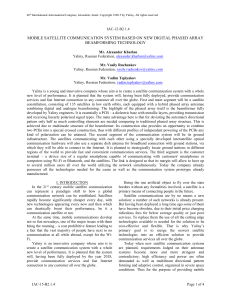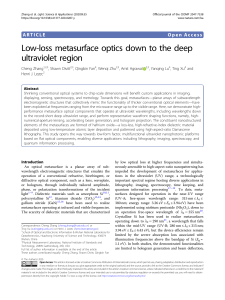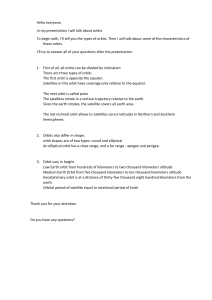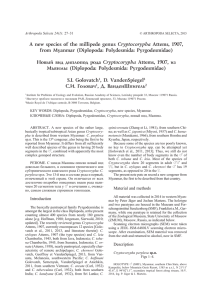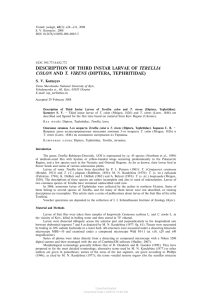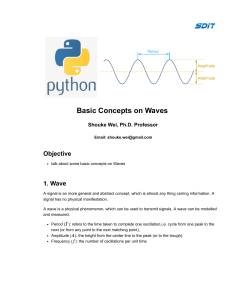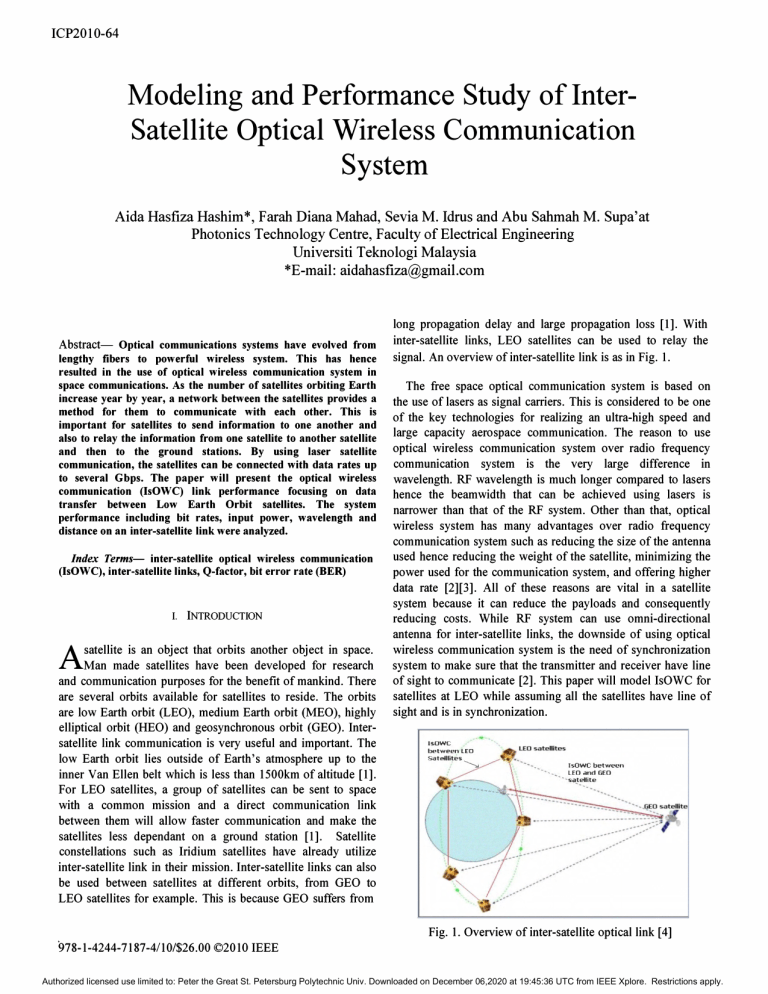
ICP2010-64 Modeling and Performance Study of Inter­ Satellite Optical Wireless Communication System Aida Hasfiza Hashim*, Farah Diana Mahad, Sevia M. Idrus and Abu Sahmah M. Supa'at Photonics Technology Centre, Faculty of Electrical Engineering Universiti Teknologi Malaysia *E-mail: aidahasfiza @ gmail.com Abstractlengthy Optical communications systems have evolved from fibers to powerful wireless system. This has hence long propagation delay and large propagation loss [I]. With inter-satellite links, LEO satellites can be used to relay the signal. An overview of inter-satellite link is as in Fig. I. resulted in the use of optical wireless communication system in space communications. As the number of satellites orbiting Earth increase year by year, a network between the satellites provides a method for them to communicate with each other. This is important for satellites to send information to one another and also to relay the information from one satellite to another satellite and then to the ground stations. By using laser satellite communication, the satellites can be connected with data rates up to several Gbps. The paper will present the optical wireless communication transfer (IsOWC) between Low link performance Earth Orbit focusing satellites. The on data system performance including bit rates, input power, wavelength and distance on an inter-satellite link were analyzed. Index Terms- inter-satellite optical wireless communication (IsOWC), inter-satellite links, Q-factor, bit error rate (BER) I. INTRODUCTION satellite is an object that orbits another object in space. AMan made satellites have been developed for research and communication purposes for the benefit of mankind. There are several orbits available for satellites to reside. The orbits are low Earth orbit (LEO), medium Earth orbit (MEO), highly elliptical orbit (HEO) and geosynchronous orbit (GEO). Inter­ satellite link communication is very useful and important. The low Earth orbit lies outside of Earth's atmosphere up to the inner Van Ellen belt which is less than 1500km of altitude [I]. For LEO satellites, a group of satellites can be sent to space with a common mission and a direct communication link between them will allow faster communication and make the satellites less dependant on a ground station [I]. Satellite constellations such as Iridium satellites have already utilize inter-satellite link in their mission. Inter-satellite links can also be used between satellites at different orbits, from GEO to LEO satellites for example. This is because GEO suffers from The free space optical communication system is based on the use of lasers as signal carriers. This is considered to be one of the key technologies for realizing an ultra-high speed and large capacity aerospace communication. The reason to use optical wireless communication system over radio frequency communication system is the very large difference in wavelength. RF wavelength is much longer compared to lasers hence the beamwidth that can be achieved using lasers is narrower than that of the RF system. Other than that, optical wireless system has many advantages over radio frequency communication system such as reducing the size of the antenna used hence reducing the weight of the satellite, minimizing the power used for the communication system, and offering higher data rate [2][3]. All of these reasons are vital in a satellite system because it can reduce the payloads and consequently reducing costs. While RF system can use omni-directional antenna for inter-satellite links, the downside of using optical wireless communication system is the need of synchronization system to make sure that the transmitter and receiver have line of sight to communicate [2]. This paper will model IsOWC for satellites at LEO while assuming all the satellites have line of sight and is in synchronization. IsOWC between LEO Sateillites � .. ... .......... .. IsOWC between LEO and GEO .... sateHlte ........ Fig. 1. Overview of inter-satellite optical link [4] 978-1-4244-7187-4110/$26.00 ©201O IEEE Authorized licensed use limited to: Peter the Great St. Petersburg Polytechnic Univ. Downloaded on December 06,2020 at 19:45:36 UTC from IEEE Xplore. Restrictions apply. ICP2010-64 II. INTER-SATELLITE MODEL This paper models inter-satellite links between four LEO satellites in a constellation as in Fig. 2. The satellites communicate in full duplex using optical system and Optiwave OptiSystem software is used to simulate the model. The block diagram of a simplex IsOWC which is a one way data transmission model is shown in Fig. 3. The circuit using OptiSystem of an inter-satellite link between two adjacent satellites is as shown in Fig. 4. A full-duplex communication in optical system consists of two simplex systems. Therefore in order to analyze the IsOWC system, a simplex communication between two satellites is used [4]. The optical communication system receives information from the satellite's Telemetry, Tracking and Communications (TT&C) system which then will be modulated with an optical light generated by an injected laser diode (lLD). The output of the modulator will be transmitted by Satellite 1 through the optical wireless channel. The received light ray at Satellite 2 will be detected by a photodiode which will be followed by a low pass filter (LPF). The output of the LPF will then be sent to Satellite 2's TT&C system for further data processing. Performance of an IsOWC system is highly affected by the distance between the satellites and the system bit rate. Therefore this paper focuses on studying the relationship of these factors onto the systems performance. Fig. 2. IsOWC model Optical Rece�er , I , I I ·-[l· · · ·�' -f-+iI , f-i}"" lfr' � - W I ------ I 1';t,t" 'II'li ..",1 hWr'; 'w.c/.'!(" . . /ro o.f·· "O;,,· Fl' 1' R""'" fe ;;ti ' lill :iI; . , . .. , h" ·N""." . C:.rJIt;1;';� 'C ::·'b;;j:;�i •••••••• J.� �ll �� ••••••••• � ;'l" ::\ 'if Fig. 3. IsOWC simplex design model --_ . . . : .. . EE� ",:. ....... -� � -- ---- SA I1El SA1B.lIlE2 Fig. 4. Full·duplex IsOWC between two satellites III. RESULTS AND DISCUSSION By varying the values of distance between the two satellites and the bit rates in the OptiSystem model, the value of maximum attainable Q-factor is obtained. The input optical power was maintained at 10 dBm and the transmit wavelength is 1550 nm whereas the distance was set from 0 km up to 5000 km. The bit rate was set at 5 levels which are 1 Mbps, 10 Mbps, 100 Mbps, 1 Gbps and 10 Gbps. The graph of maximum Q-factor is plotted as in Fig. 5. Higher Q·factor means less bit-error rate (BER) which leads to better performance of the system. From Fig. 5, it can be observed that Q·factor is inversely proportional to the distance. Q·factor is also inversely proportional with bit·rate, whereby at the same distance signal with lower bit-rate produces higher Q-factor compared to signals of higher bit·rate. It can also be studied that signal at lower bit-rate can travel further at the same input optical power. From the simulation it was observed that for Q-factor below than 5, the received signal was poor and the BER was more than 10-5• From the graph, at distance 5000 km, the IsOWC can only be received at bit rate of 1 Mbps. Therefore, in order to send signals at higher data rate over a longer distance, higher input power is needed or amplification can be done either at the transmitter or at the receiver. It was also acknowledged that signals with high Q-factor has better eye diagram with higher eye·heights. Fig. 6 shows the eye diagram of an IsOWC system with distance of 1000 km and bit rate of 10 Mbps that produces very minimum errors with a recorded Q·factor of 48.04. When the distance is increased from 1000 km to 3000 km with the same bit rate, the eye diagram consists of more jitter and the opening of the eye decreases as shown in Fig. 7. Authorized licensed use limited to: Peter the Great St. Petersburg Polytechnic Univ. Downloaded on December 06,2020 at 19:45:36 UTC from IEEE Xplore. Restrictions apply. ICP2010-64 At long haul transmission, the common wavelength used is 1550 nm. However, shorter wavelength can also be implemented. Fig. 8 and Fig. 9 show the effect on the system performance when the wavelengths are varied. For this simulation, the distance between the satellites is set constant at 200 km and bit rate of 1 Gbps are used. Time (bit pe,.iod) 0.5 Fig. 5. Max Q-factor versus distance for different bit rates 0.5 Fig. 8. Eye diagram at 850 nm wavelength lime (bit penod) 0.0 < 0.5 Fig. 6. Eye diagram for modeled IsOWC system at distance 1000 km and 10 Mbps 0.5 Time bit e ... iod Fig. 9. Eye diagram at 1550 nm wavelength It can be observed that at higher wavelength, more error is produced due to lower value Q-factor. However, by using longer wavelength, the effect of scattering can be reduced. Attenuation due to Rayleigh and Mie scattering is inversely proportional to the wavelength. Though, in this project it is assumed that there are no particles obstructing the light signal, but small and large particles such as space dusts and meteorites can be within the light signal's way. Therefore, the longest possible wavelength is 1550 nm. IV. CONCLUSION Fig. 7. Eye diagram for modeled IsOWC system at distance 3000 km and 10 Mbps In this paper, inter-satellite links and application of optical wireless communication were fully understood. The IsOWC Authorized licensed use limited to: Peter the Great St. Petersburg Polytechnic Univ. Downloaded on December 06,2020 at 19:45:36 UTC from IEEE Xplore. Restrictions apply. ICP2010-64 simulation and modeling can be done in OptiWave OptiSystem software. From the IsOWC model and simulation results, it can be concluded that signals with smaller bit rate travel further than the one with higher bit rate. Besides, the received error increases as the distance between the satellites increase. Even so, optical wireless signal can travel further than using RF system. It can also be concluded that the IsOWC system can perform better by having an amplifier to travel further. Even though longer signal wavelength produces more errors but transmission at 1550 nm is used to reduce the effect of scattering and for its compatibility with existing devices. ACKNOWLEDGMENT The authors acknowledge the Ministry of Science, Technology and Innovation Malaysia for the financial support through EScience funding 01-01-06SF0488. Our gratitude also goes to the administration of Universiti Teknologi Malaysia (UTM) especially the Research Management Centre (RMC) and Human Resources Department (HRD) for the financial support. We would also like to show our appreciation towards Photonics Technology Center and Faculty of Electrical Engineering that had provided us the equipments to accomplish this work. REFERENCES [1] A. Jamalipour, Low Earth Orbital Satellites for Personal Communication Networks, Artech House Publisher, UK, 1999. [2] Z. Sun, Satellite Networking - Principles and Protocols, John Wiley & Sons, UK, 2005. [3] V. W. S. Chan, "Optical Satellite Networks", Journal of Lightwave Technology, vol. 21, no. 11, November 2003, pp. 2811-2817. [4] S. M. Idrus, Unguided Optical Communication System: Investigation the Effects o/Various Atmospheric Weather Conditions on Unguided Optical Link, Universiti Teknologi Malaysia, 1998. [5] R. Ramirez-Iniguez, S. M. Idrus, Z. Sun, Optical Wireless Communication: IR/or Wireless Connectivity, Auerbach Publications, USA, 2008. [6] M. A. Krainak, "Inter-satellite Communications Optoelectronics Research at the Goddard Space Flight Center", IEEE AES Systems Magazine, September 1992, pp. 44-47. [7] M. Pfennigbauer, W. R. Leeb, "Free-Space Optical Quantum Key Distribution Using Inter-satellite Links", CNES Inter-satellite Link Workshop, November 2003. Authorized licensed use limited to: Peter the Great St. Petersburg Polytechnic Univ. Downloaded on December 06,2020 at 19:45:36 UTC from IEEE Xplore. Restrictions apply.

